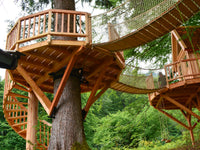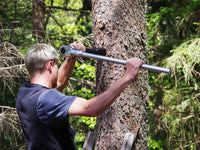Step 5: The right tree for your treehouse
Expert knowledge from Treehouse Pros:
✔ Studies show: Tree Bolts, TABs and Garnier Limbs are safe and gentle on trees in the long term
✔ Trees with a thickness of 30 cm or more are suitable for treehouses
✔ Only healthy trees are suitable
✔ The tree needs to heal well (beech, oak, maple, etc.)

Ready for a Treehouse Fastening?
Before building a treehouse, the tree should be carefully examined. In practice, ‘visual tree inspection’ has proven to be effective:
This allows you to assess the health of the tree sufficiently well and determine whether it can safely support a treehouse and whether it is suitable for fastening with tree bolts.
We'll show you what to look out for!
The good news is that with the knowledge and practical experience we share here, you can assess the tree visually and choose the right one with confidence!
Professional testing methods such as drill cores or tree static tensile tests are too complex and expensive for private treehouses.
1. Which tree is suitable for a treehouse?
Every tree is unique – just like our friend in the picture ;)
The quality of wood varies not only from tree to tree, but also depends on location factors such as soil conditions, climate and age – even within a single tree there are differences.
Nevertheless, there are tree species that are better suited for building treehouses than others. We have examined the 37 most common treehouse trees in Europe, North America and North Asia.
Here is the table + free PDF downloads:
⬇️ This table in the following languages: DE, EN, ES, FR
⬇️ Detailed list of trees, with wood strength & wound healing: DE, EN

1. Which tree is suitable for a treehouse?
Every tree is unique – just like our friend in the picture ;)
The quality of wood varies not only from tree to tree, but also depends on location factors such as soil conditions, climate and age – even within a single tree there are differences.
Nevertheless, there are tree species that are better suited for building treehouses than others. We have examined the 37 most common treehouse trees in Europe, North America and North Asia.
Here is the table + free PDF downloads:
⬇️ This table in the following languages: DE, EN, ES, FR
⬇️ Detailed list of trees, with wood strength & wound healing: DE, EN

Table: The best (and worst) trees for treehouses
In collaboration with other treehouse builders and tree experts, we have evaluated numerous studies and compared them with our professional experience. Our goal was to classify tree species as accurately as possible according to their suitability for treehouse construction.
Decisive for the use of tree bolts, TAB or Garnier Limb:
✔ High wood strength for high load capacity of the tree bolts
✔ Good wound healing and sealing ‘Depends heavily on the vitality of the tree’ - Handbook of Tree Statics, 2023 (for drill holes)
The treehouse tree should above all be healthy and mature – this will enable it to respond well to changes!
Avoid additional stress and support the treehouse tree by watering it sufficiently during long dry periods.
2. How big does a treehouse tree need to be?
When building a treehouse, it is not the height of the tree that counts, but above all its health and a strong trunk diameter! If you have several trees to choose from, you should first look for healthy, thick specimens – for good reasons:
✔ A thick tree is mature and resilient.
✔ It has proven that it can withstand extreme weather conditions (storms, drought, hail, broken branches, etc.).
✔ Its solid trunk moves less in the wind, which protects the treehouse construction.
✔ A mature tree usually has very high energy reserves for wound healing Handbook of Tree Statics, 2023 - Thomas Sinn – ideal for secure fastening with tree bolts.

2. How big does a treehouse tree need to be?
When building a treehouse, it is not the height of the tree that counts, but above all its health and a strong trunk diameter! If you have several trees to choose from, you should first look for healthy, thick specimens – for good reasons:
✔ A thick tree is mature and resilient.
✔ It has proven that it can withstand extreme weather conditions (storms, drought, hail, broken branches, etc.).
✔ Its solid trunk moves less in the wind, which protects the treehouse construction.
✔ A mature tree usually has very high energy reserves for wound healing Handbook of Tree Statics, 2023 - Thomas Sinn – ideal for secure fastening with tree bolts.


From trunk diameter > 30 cm (11.8 in)
If you want to attach a treehouse to a tree, the tree should have a trunk diameter of at least 30 cm (11.8 in) at the height of the platform – the thicker, the better!
For treehouse construction, a thick trunk means:
✔ More safety
✔ More design options
✔ The treehouse can be large and heavy
✔ The house can be attached high up in the tree
✔ The house can protrude further to the side (less swaying, less twisting)
Tree trunks from 30 cm are suitable for installing tree bolts – one of the safest and most sustainable fastening techniques in the long term.
Buy GTS tree bolts here!
Is the tree too small?
Not everyone has a huge dream tree in their garden, but that doesn't matter. You can also build great treehouses in fruit trees that are 5 m (16.4 ft) high – a mixture of treehouse and raised stilt treehouse is often the best solution here.
Very small and young trees with a trunk diameter of less than 30 cm (11.8 in) at waist height should be left alone.
The treehouse should not take up more than 20% of the crown volume, otherwise the tree will be ‘visually crushed’.







Tribeam Attachment Kit – for small, thin trees
✔ Ideal for small, lightweight platforms
✔ Flexible bracket for tree stilt houses
✔ For tree trunks from 30 cm (11.8 in)
✔ Tree-friendly and safe!
3. Visual tree inspection – Is the tree healthy?
To ensure long-term safety, treehouses should only be built in absolutely healthy trees! For private and smaller treehouse projects, a visual assessment of the tree is sufficient, as proven and confirmed by decades of practical experience by tree experts.
But how can I tell if the tree is healthy?
You can see whether the tree is healthy or sick, just like with a human being.

Visible warning signs!
Similar to humans (posture, skin, hair, scars, etc.), trees also show visible signs of poor health.
Do not build or attach a treehouse to trees with the following characteristics:
❌ unhealthy crown (few and irregular leaves)
❌ many dead branches (without leaves)
❌ long cracks
❌ dying bark (fungus or pests!)
❌ woodpecker (insect infestation!)
❌ deep cavities
❌ hollow sound (tap test with a hammer)
❌ many secondary shoots (new ‘panic shoots’ in the middle of the trunk)
❌ fungal fruiting bodies!

The tree's surroundings
In addition to the tree itself, be sure to observe its location and surroundings – look out for these warning signs!
❌ Soil that is too soft (roots cannot anchor properly)
❌ Very wet soil or flood-prone area
❌ Tree on a steep slope (tree may tip over)
❌ Fungal or pest infestation on neighbouring trees
❌ Species-specific diseases, e.g. ash and elm dieback, chestnut (leaf miner) and spruce (bark beetle)!
In case of doubt or for public projects, it is always advisable to consult a tree biologist or tree expert. Local tree experts know their environment best.
4. Warning signs – images & examples
A good first indication of a tree's health is its crown. If the tree is under stress or its health is declining, this can be easily recognised by a ‘dishevelled crown’ (see image):
❌ Many thick dead branches
❌ Irregular or sparse foliage / needle deficit
There can be many causes: lack of water, lack of nutrients, poor soil quality, pests, fungal infestation, etc.
An already stressed tree should not be disturbed further by building a treehouse.
4. Warning signs – images & examples
A good first indication of a tree's health is its crown. If the tree is under stress or its health is declining, this can be easily recognised by a ‘dishevelled crown’ (see image):
❌ Many thick dead branches
❌ Irregular or sparse foliage / needle deficit
There can be many causes: lack of water, lack of nutrients, poor soil quality, pests, fungal infestation, etc.
An already stressed tree should not be disturbed further by building a treehouse.
Warning sign – better not attach a treehouse here!
Here are a few examples of trees in which a treehouse should not be attached. The main reason: their statics and stability are not guaranteed in the long term.
Such trees are already weakened and need their energy to survive. In addition, falling dead wood poses a danger to people. Anyone planning to build a treehouse or similar structure near such weakened trees should consult a professional arborist to check that it is safe.

Holes in the tree
❌ Do not build here!
❌ Holes indicate pests and large cavities.
❌ Structural integrity and health very poor
❌ Tree will die soon

Bark peeling off – pests!
❌ Unhealthy, pitted and peeling bark is a sign of pest or fungal infestation.
❌ This destroys the cambium and wood, causing the tree to die quickly.
❌ ALL NEIGHBOURING TREES ARE AT RISK!

Long cracks
❌ Long cracks indicate that the wood fibres are already damaged
❌ Stability not guaranteed
❌ Tree is already struggling with stress
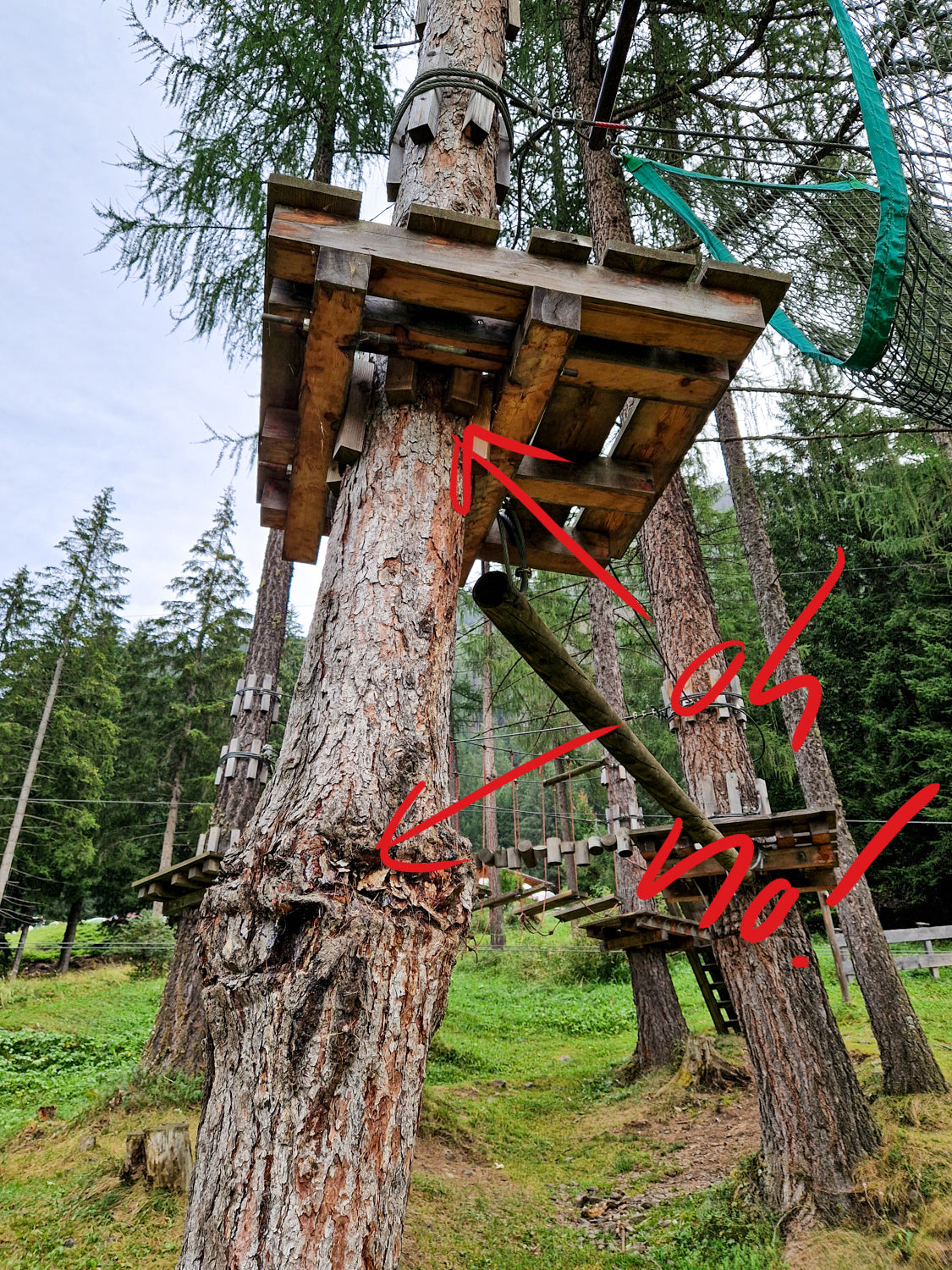
predetermined breaking points
❌ Typical damage caused by clamping fastenings.
❌ Bruising weakens the structure and can become predetermined breaking points!
❌ Nutrient supply disrupted

Hollow tree
❌ The tree crown, foliage and branches appear unhealthy.
❌ Structural integrity unclear – may change quickly!
❌ Although these trees can still live for a very long time, let them grow old in peace.
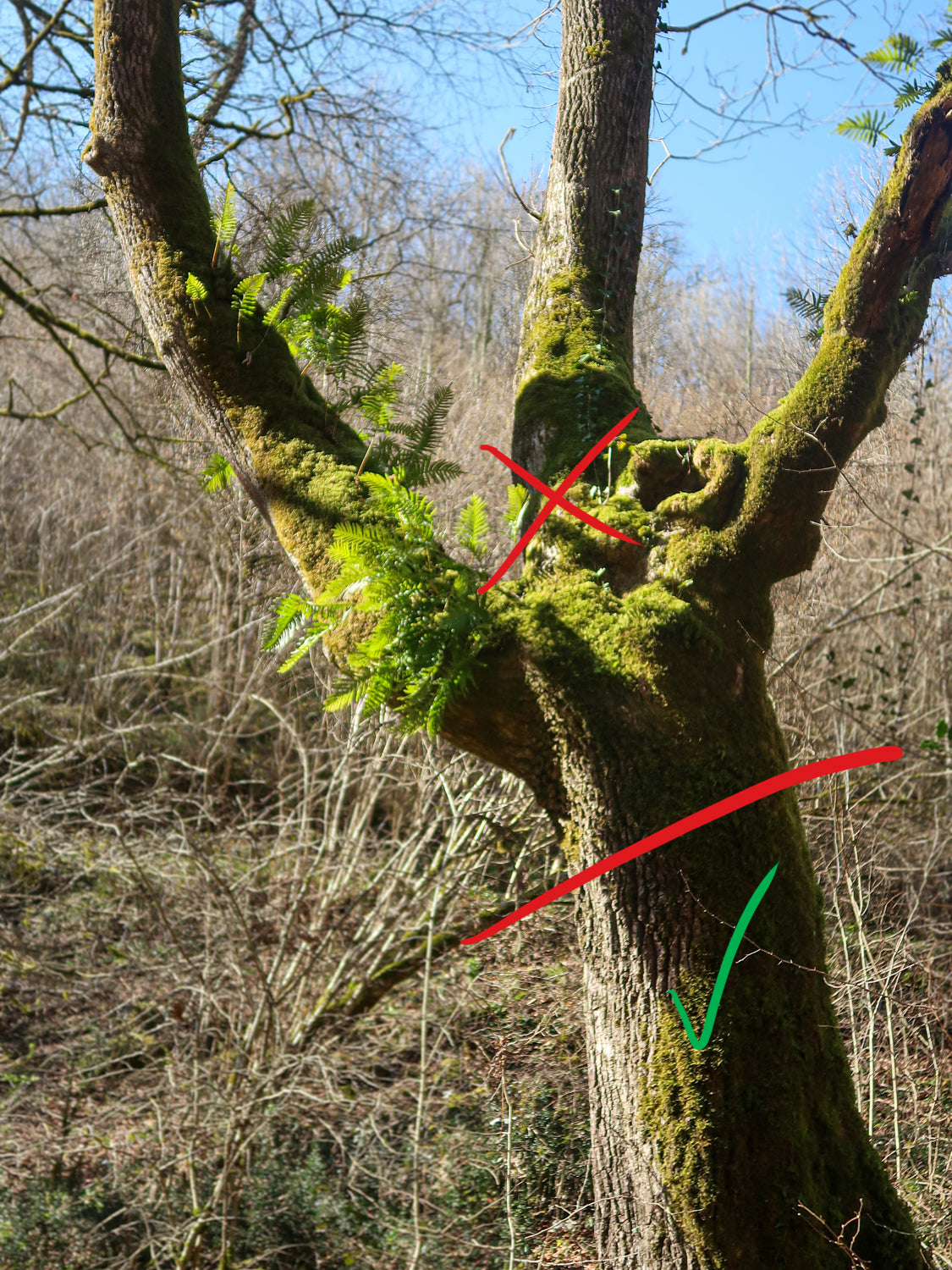
Alien plants and rot
✔ In theory, construction is still possible in the lower area.
❌ The upper area is unsuitable.
❌ Standing moisture and rot in large holes.
❌ Tree trunk weakened in a critical area.
5. Building treehouses in crooked trees?
It often happens that a tree is healthy but stands crooked or has a special growth form. To a certain extent, it is certainly possible to build a treehouse, but there are a few structural considerations to bear in mind:
✔ No large lever arms on crooked trees
✔ No additional load in the ‘tilting direction’
✔ For crooked trees, only attach the treehouse to the lower trunk area
✔ For trees with a steep incline, it is better to build the treehouse on stilts
5. Building treehouses in crooked trees?
It often happens that a tree is healthy but stands crooked or has a special growth form. To a certain extent, it is certainly possible to build a treehouse, but there are a few structural considerations to bear in mind:
✔ No large lever arms on crooked trees
✔ No additional load in the ‘tilting direction’
✔ For crooked trees, only attach the treehouse to the lower trunk area
✔ For trees with a steep incline, it is better to build the treehouse on stilts
Treehouse trees – hit or miss?
Let's take a look at a few special trees to see if they are suitable for treehouse fastening – tips from the treehouse professional:

Crooked banana on a hillside
❌ Avoid leaning trees on steep slopes
❌ Risk of tipping
❌ If fastening: low load, far down, on the slope side

Curved multiple trunk
✔ Straight, fast-growing trunks are ideal for treehouses
✔ Sloping trunks can be made safer with professional ‘relief cuts’.
❌ Do not place heavy loads on sloping trunks – risk of tipping!

Straight multiple trunk
✔ Straight, fast-growing trunks
✔ Very suitable
✔ Consider wind fluctuations if the treehouse is to be built high up
❌ Check: cracks and rot at forks
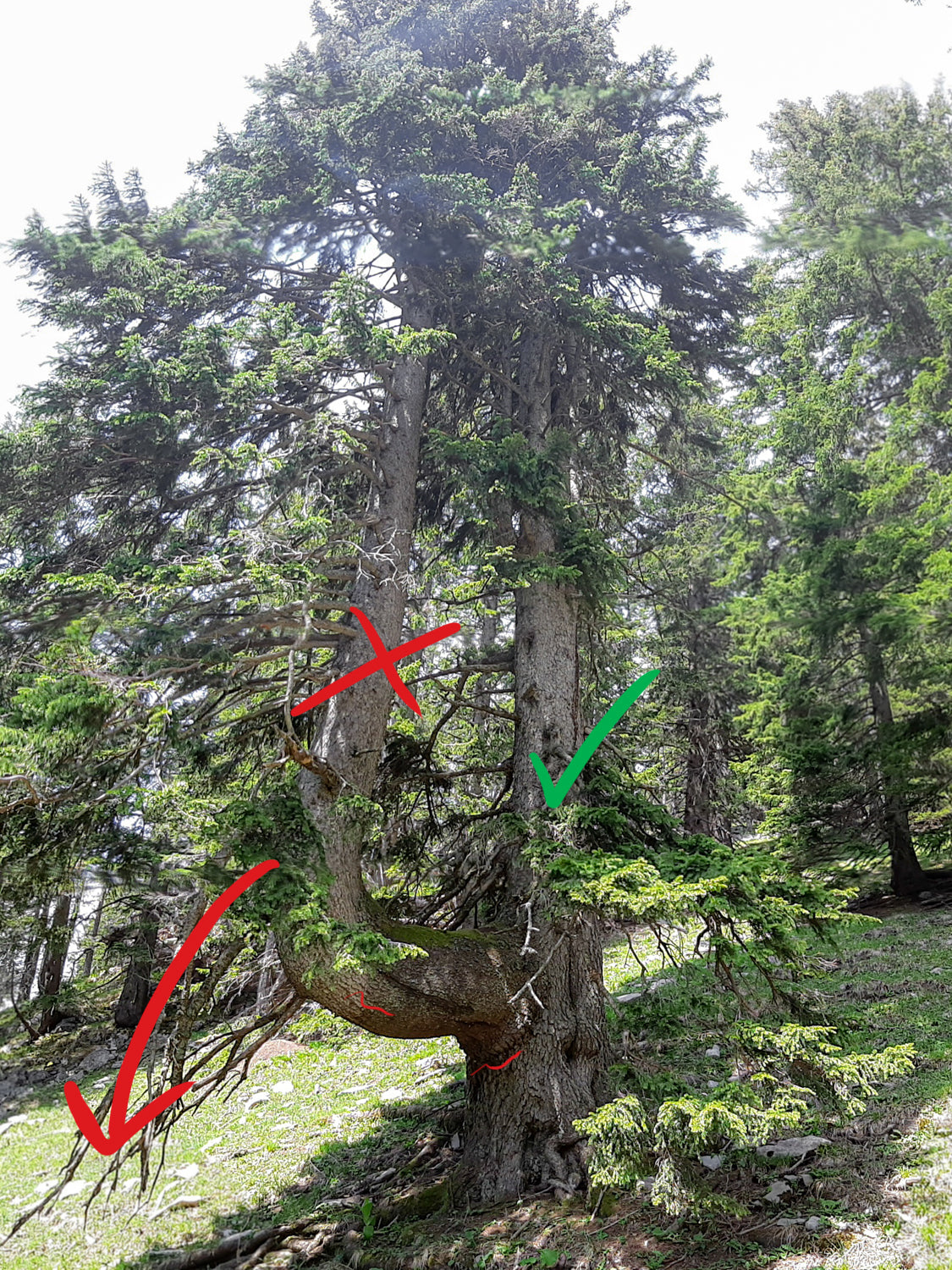
Poorly attached side branch
✔ Straight trunk is suitable
❌ Massive side shoots are not well connected to the main trunk
❌ Visible cracks & bruising
❌ Risk of breakage!

Treehouse-Pro in training
That's me, Vitus Wahlländer. I have diligently gathered the knowledge presented here as a professional treehouse builder, in specialist books and through exchanges with other tree experts.
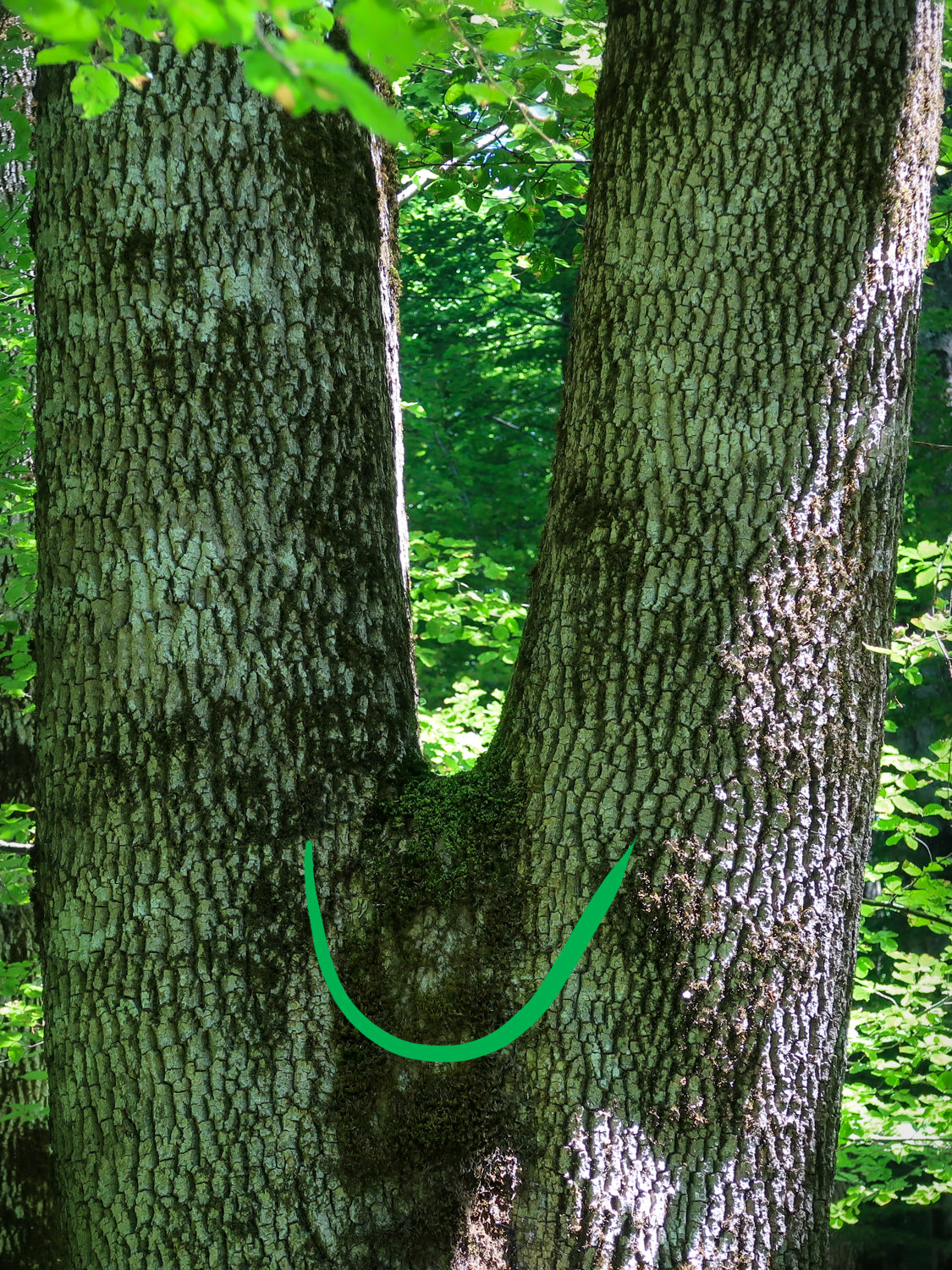
Hairy forked U-shaped piece
✔ The tree trunk splits
✔ U-shape is generally considered more stable and safer than V-forked
✔ Well suited for fastenings

Shaved V-shaped forked tip
✔ Do not place too much weight above the fork!
✔ According to the latest study, much more stable than previously assumed (Steffen Rust, 2024)
❌ Risk of damage in the event of long cracks and rot!

twisting growth
❌ Do not use twisted trees like this one for treehouses
❌ Unknown structural integrity & wood strength

Kissing lovers
✔ Straight conifer could be suitable
✔ Only for small treehouses
❌ Roots & stability unknown
❌ No heavy loads
6. Conclusion – The perfect treehouse tree
There is no such thing as the ‘best treehouse tree’. However, there are tree species that are more suitable than others due to their wood strength and wound healing properties. However, wound healing can only work if the tree is healthy!
The following criteria are a basic requirement for the installation of Tree Bolts, TABs, Garnier Limbs, threaded rods and similar items:
✔ The tree is healthy
✔ The trunk diameter is at least 30 cm (11.8 in)
✔ It is generally suitable for tree bolts (see table above)
If your tree does not meet these criteria (too small, diseased or too old), you should leave it alone and build your treehouse on stilts.
If you are unsure or have any questions, we will be happy to help you:

6. Conclusion – The perfect treehouse tree
There is no such thing as the ‘best treehouse tree’. However, there are tree species that are more suitable than others due to their wood strength and wound healing properties. However, wound healing can only work if the tree is healthy!
The following criteria are a basic requirement for the installation of Tree Bolts, TABs, Garnier Limbs, threaded rods and similar items:
✔ The tree is healthy
✔ The trunk diameter is at least 30 cm (11.8 in)
✔ It is generally suitable for tree bolts (see table above)
If your tree does not meet these criteria (too small, diseased or too old), you should leave it alone and build your treehouse on stilts.
If you are unsure or have any questions, we will be happy to help you:

Finally, a dream project with perfect treehouse trees:
This huge treehouse adventure trail was planned and built by our carpentry company baumbaron GmbH. Securely fastened with our GTS Tree Bolts – and open to the public in Schlosspark Moyland in Germany.


GTS Tree Bolts
These thick trees are perfect for fastening with tree bolts!
Safe constructions
The more solid the tree, the larger and heavier the platform construction can be.
This beech tree is a dream come true:
✔ High wood strength
✔ Solid trunk
✔ Straight growth
✔ Healthy


Mature, vigorous trees
Over several decades, this oak tree has proven that it can withstand all weather extremes and environmental influences – perfect conditions for a treehouse!
High level of safety
The GTS Fastening System provides maximum load capacity and safety in these deciduous trees – even with large groups of people!
Well protected
The trees are well protected from storms in the middle of the wall.

